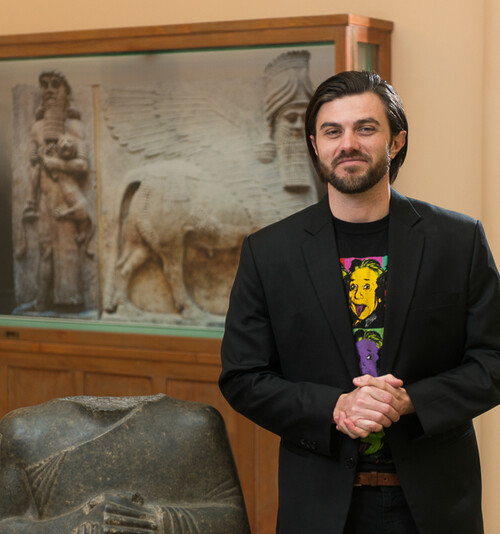Adam Anderson

When most students go to the library, they’re looking for texts written on paper, not clay. Not so for Adam Anderson, a PhD candidate in the Department of Near Eastern Languages and Civilizations focusing on Akkadian and Sumerian studies and a 2014 Harvard Horizons scholar.
In fact, as far as Anderson’s research goes, the well-organized drawers of cuneiform tablets at the Harvard Semitic Museum are quite tame: He recalls the time when, while doing fieldwork in the Middle East, he was approached by a man offering to sell him a bag of tablets through the black market—a far cry from a trip to the bookstore. For the record, Anderson didn’t buy them. “It would only have undermined what I’m trying to do as a scholar,” he says, “which is to provide context to history rather than remove history from its context.”
Led by Linguistic Curiosity
Anderson has long been fascinated with centuries past. “I’ve always been really interested in etiology, the beginnings of things, in how things start,” he says. This interest brought him to linguistics early on in college, which Anderson says “provided a scientific and philosophical method to approach a fuzzy subject such as language and ideology.” His linguistic curiosity led him to German, Greek, Hebrew, and Arabic, and later to the even older languages of Akkadian and Sumerian, along with their dialects, Assyrian and Babylonian. The rest, as they say, is history. According to Anderson, it wasn’t long before he began to feel at home in these ancient languages and fell in love with the field of Assyriology itself.
Today, Anderson is using a combination of linguistics and computer science to re-contextualize history. By combining approaches from several disciplines, including philology and social network analysis, and applying them to his study of thousands of Old Assyrian letters, Anderson hopes to “uncover the individuals of this society and restore as much of his or her historical and social-relational context as possible.” The result, Anderson jokes, is a sort of “Facebook of this ancient society.”
Modern Answer to an Ancient Problem
While most people’s eyes glaze over when Anderson tells them he studies Assyriology, at least one person’s didn’t: his collaborator David Bamman of Carnegie-Mellon University, whom he met through a mutual friend in 2010. Together, they set out to find a solution to the biggest obstacle confronting Anderson in his project: homonymy. As Anderson tried to map, by hand, the social network for a group of texts from Anatolia collectively known as the “caravan texts,” he struggled to distinguish between different people bearing the same name.
Anderson worked with Bamman to develop an algorithm that could do the kind of work Anderson had, until then, been doing by hand: mapping the relationships between traders found in some 5,000 Old Assyrian letters and documents. The result, Anderson explains, is a program of Bamman’s creation that functions using an algorithm similar to the one used by Netflix to suggest movies to its customers. By tabulating the relationships of the personal names in the textual record, their algorithm can parse out “who’s who” in Old Assyrian society.
Anderson believes that his method could have broad applications both inside the specialized confines of Assyriology and beyond. “I’d like to see it contribute to discussions currently going on about social and economic theory,” he says.
Spreading the Word
It was with the aim of spreading the word about Assyriology that Anderson applied to the Harvard Horizons program in January 2014. “Scholars in fields such as this tend to speak to each other rather than to a broader audience,” Anderson explains. “When I saw the call for applications to Horizons, I knew that I had a topic that was relevant enough to resonate with a larger crowd.”
For Anderson, another highlight of the Horizons program was getting to know his fellow scholars. “That was the best part of Horizons—exposure to other people’s cool work, and finding surprising similarities. In the end, each of us was really driven by similar questions.”After being selected for the program along with seven other graduate students, Anderson spent several hours each Friday for three months meeting with coaches who helped him refine his presentation and oratory skills. Anderson values the training he received tremendously and is especially proud of the concrete tools he gained, which allowed him to make the most of his own graphics for the presentation.
But perhaps the biggest benefit of all was the sense of confidence that Anderson gained regarding his dissertation and its potential for broader impact and interest. “I’d been working on this project for two years in isolation, so I didn’t actually know if it was good or not,” Anderson says, laughing. “It was really great to share the idea behind my dissertation before it was all written.”
Ultimately, Anderson hopes to continue bringing Assyriology into contemporary discourse and to further develop the role that digital humanities plays not only in his field, but in the adjacent fields of anthropology and sociology. “If it doesn’t appeal to the specialists, then it loses its impact,” he says. “I’m trying to do the opposite and start at a really specialized level and bring it into a larger discourse.”
For Anderson, participating in Horizons was a significant step toward achieving that goal. “Ideally, every grad student would apply,” he says. “The more you can communicate your work to a wider audience, the better off you’ll be.”

